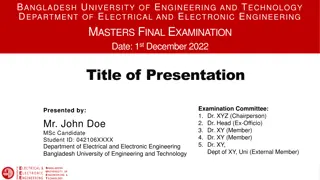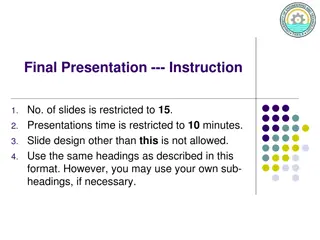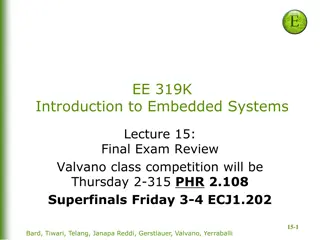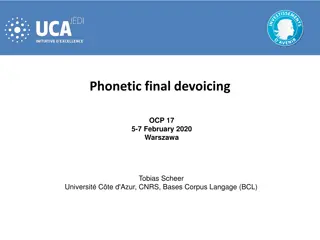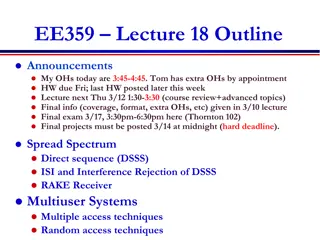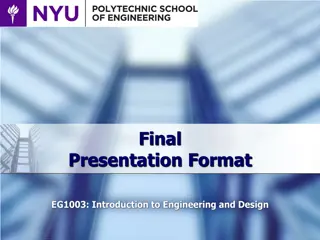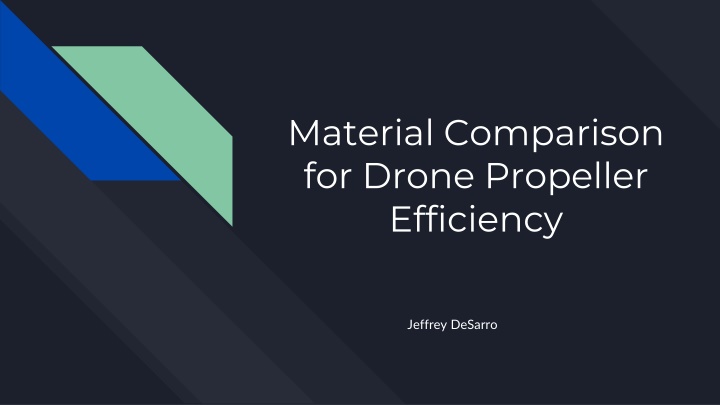
Efficiency Comparison of Drone Propeller Materials
This study by Jeffrey DeSarro compares the efficiency of drone propellers made of PLA plastic, Carbon Fiber, and Fiberglass Filled Nylon. SolidWorks software was used to design and 3D print blades of different materials, followed by efficiency testing based on input and output power measurements. Results show detailed comparisons of measured and calculated values for each material, revealing insights into which material is the most efficient for drone propeller design.
Download Presentation

Please find below an Image/Link to download the presentation.
The content on the website is provided AS IS for your information and personal use only. It may not be sold, licensed, or shared on other websites without obtaining consent from the author. If you encounter any issues during the download, it is possible that the publisher has removed the file from their server.
You are allowed to download the files provided on this website for personal or commercial use, subject to the condition that they are used lawfully. All files are the property of their respective owners.
The content on the website is provided AS IS for your information and personal use only. It may not be sold, licensed, or shared on other websites without obtaining consent from the author.
E N D
Presentation Transcript
Material Comparison for Drone Propeller Efficiency Jeffrey DeSarro
Milestones Measure reference blade Transfer measurements of reference blade to SolidWorks 2024 software 3D print blades of different types of materials: PLA plastic, Carbon Fiber, Fiberglass Filled Nylon Test out 3D printed blades Determine which material is the most efficient
Efficiency Measure input power (electrical power) and output power (mechanical power) Output Power ______________ __ Input Power X 100% Efficiency = Input Power = Voltage x Current Output Power = Torque x Angular Velocity 2 x x RPM Angular Velocity = _______________ Torque = Thrust x Propeller Radius 60
Results: PLA Plastic Measured Values: Calculated Values: Voltage: 17.74 V Amperage: 0.86 A Thrust: 0.06063022936 N Radius of blade: 0.2984252 in RPM: 5000 Angular Velocity: 523.5987756 rad/s Torque: 0.01809358832 Efficiency Output: 9.473780692 Efficiency Input: 15.2564 Efficiency: 0.6209709166
Results: Carbon Fiber Calculated Values: Angular Velocity: 523.5987756 rad/s Torque: 0.01981586817 Efficiency Output: 10.37556431 Efficiency Input: 16.6756 Efficiency: 0.6222003593 Measured Values: Voltage: 17.74 V Amperage: 0.94 A Thrust: 0.06640145729 N Radius of blade: 0.2984252 in RPM: 5000
Results: Fiberglass Filled Nylon Measured Values: Calculated Values: Angular Velocity: 523.5987756 rad/s Torque: 0.01235331926 Efficiency Output: 6.468182837 Efficiency Input: 9.4022 Efficiency: 0.6879435491 Voltage: 17.74 V Amperage: 0.53 A Thrust: 0.04139502715 N Radius of blade: 0.2984252 in RPM: 5000
Comparison of Results PLA Plastic: 62.1% Carbon Fiber: 62.22% Fiberglass Filled Nylon: 68.8% Overall, the fiberglass filled nylon was the most efficient out of the 3 materials tested









